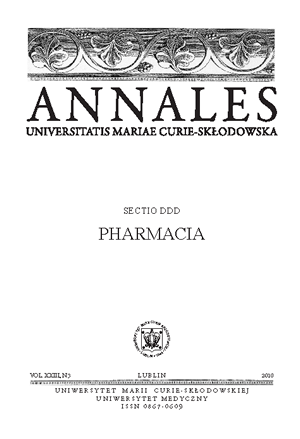Wpływ 7-nitroindazolu i NG-nitro-L-argininy na ochronne działanie klobazamu w teście maksymalnego wstrząsu elektrycznego u myszy
Słowa kluczowe:
7-Nitroindazol, NG-nitro-L-arginina, klobazam, tlenek azotu, maksymalny wstrząs elektryczny.Abstrakt
Celem pracy była ocena wpływu 7-nitroindazolu (7NI – preferencyjnego inhibitora neuronalnej syntazy tlenku azotu [NOS]) i NG-nitro-L-argininy (NNA – nieselektywnego inhibitora NOS) na przeciwdrgawkowe działanie klobazamu (CLB – leku przeciwpadaczkowego drugiej generacji) w modelu maksymalnego wstrząsu elektrycznego (MES) u myszy. Drgawki elektryczne były wywoływane u dorosłych samców myszy Albino Swiss poprzez prąd zmienny (50Hz, 500V, 25mA, elektrody uszne, 0,2s czas trwania impulsu). Przeciwdrgawkowe działanie CLB w teście MES wyrażono jako mediany dawek skutecznych (wartości ED50) leku, chroniące 50% zwierząt przed drgawkami wywoływanymi elektrycznie. Ostre potencjalne działania niepożądane CLB w kombinacji z 7NI i NNA oceniono w teście komina (koordynacja ruchowa), teście biernego unikania (pamięć długotrwała) i teście chwytania (siła mięśni szkieletowych) u myszy. Wyniki wskazują, że 7NI (50 mg/kg; i.p.) istotnie nasilał przeciwdrgawkowe działanie CLB poprzez zmniejszenie jego wartości ED50 z 15,14 mg/kg do 10,23 mg/kg (p<0,05). Podobnie, 7NI w niższej dawce 25 mg/kg również nasilał przeciwdrgawkową aktywność CLB, chociaż wyniki nie uzyskały istotności statystycznej. Przeciwnie, NNA (40 mg/kg; i.p.) nie miała żadnego wpływu na przeciwdrgawkowe działanie CLB. Ponadto, żadna z badanych kombinacji CLB z 7NI i NNA nie wpływała na koordynację ruchową, pamięć długotrwałą i siłę mięśni szkieletowych u myszy. W oparciu o to badanie przedkliniczne, można stwierdzić, że 7NI istotnie nasilał, podczas gdy NNA nie miała wpływu na przeciwdrgawkowe działanie CLB w teście MES u myszy.
Bibliografia
1. Babbedge R.C., Bland-Ward P.A., Hart S.L. et al.: Inhibition of rat cerebellar nitric oxide synthase by 7-nitro indazole and related substituted indazoles. Br. J. Pharmacol., 110, 225, 1993.
2. Baran L., Siwanowicz J., Przegaliński E.: Effect of nitric oxide synthase inhibitors and molsidomine on the anticonvulsant activity of some antiepileptic drugs. Pol. J. Pharmacol., 49, 363, 1997.
3. Boissier J.R., Tardy J., Diverres J.C.: A simple novel method to explore tranquilizer activity: the chimney test (in French). Med. Exp. (Basel), 3, 81, 1960.
4. Borowicz K.K., Kleinrok Z., Czuczwar S.J.: Influence of 7-nitroindazole on the anticonvulsive action of conventional antiepileptic drugs. Eur. J. Pharmacol. 331, 127, 1997.
5. Borowicz K.K., Starownik R., Kleinrok Z. et al.: The influence of L-NG-nitroarginine methyl ester, an inhibitor of nitric oxide synthase, upon the anticonvulsive activity of conventional antiepileptic drugs against maximal electroshock in mice. J. Neural Transm. 105, 1, 1998.
6. Fujiwara A., Watanabe Y., Takechi K. et al.: The usefulness of olfactory bulb kindling as a model for evaluation of antiepileptics. Epilepsia 51, 445, 2010.
7. Haugvicova R., Kubova H., Mares P.: Antipentylenetetrazol action of clobazam in developing rats. Physiol. Res. 48, 501, 1999.
8. Ishikawa T., Fujiwara A., Takechi K. et al.: Effects of antiepileptics on lateral geniculate nucleus-kindled seizures in rats. J. Pharmacol. Sci., 109, 540, 2009.
9. Litchfield J.T., Wilcoxon F.: A simplified method of evaluating dose-effect experiments. J. Pharmacol. Exp. Ther. 96, 99, 1949.
10. Löscher W., Fassbender C.P., Nolting B.: The role of technical, biological and pharmacological factors in the laboratory evaluation of anticonvulsant drugs. II. Maximal electroshock seizure models. Epilepsy Res., 8, 79, 1991.
11. Łuszczki J.J., Czuczwar M., Gawlik P. et al.: 7-Nitroindazole potentiates the anticonvulsant action of some second-generation antiepileptic drugs in the mouse maximal electroshock-induced seizure model. J. Neural Transm., 113, 1157, 2006.
12. Łuszczki J.J., Czuczwar M., Gawlik P. et al.: Influence of NG-nitro-L-arginine on the anticonvulsant and acute adverse effects of some newer antiepileptic drugs in the maximal electroshock-induced seizures and chimney test in mice. Pharmacol. Rep., 58, 955, 2006.
13. Łuszczki J.J., Jaskólska A., Dworzański W. et al.: 7-Nitroindazole, but not NG-nitro-L-arginine, enhances the anticonvulsant activity of pregabalin in the mouse maximal electroshock-induced seizure model. Pharmacol. Rep., In press, 2010.
14. Łuszczki J.J., Ratnaraj N., Patsalos P.N. et al.: Isobolographic analysis of interactions between loreclezole and conventional antiepileptic drugs in the mouse maximal electroshock-induced seizure model. Naunyn Schmiedebergs Arch. Pharmacol., 373, 169, 2006.
15. Łuszczki J.J., Sacharuk A., Wojciechowska A. et al.: 7-Nitroindazole enhances dose-dependently the anticonvulsant activities of conventional antiepileptic drugs in the mouse maximal electroshock-induced seizure model. Pharmacol. Rep., 58, 660, 2006.
16. Łuszczki J.J., Zadrożniak A., Barcicka-Kłosowska B. et al.: Influence of 7-nitroindazole and NG-nitro-L-arginine on the anticonvulsant activity of loreclezole in maximal electroshock-induced seizures in mice. J. Pre-Clin. Clin. Res., 1, 146, 2007.
17. Moncada S., Higgs E.A.: Molecular mechanisms and therapeutic strategies related to nitric oxide. FASEB J,. 9, 1319, 1995.
18. Riss J., Cloyd J., Gates J. et al.: Benzodiazepines in epilepsy: pharmacology and pharmacokinetics. Acta Neurol. Scand., 118, 69, 2008.
19. Shenoy A.K., Miyahara J.T., Swinyard E.A. et al.: Comparative anticonvulsant activity and neurotoxicity of clobazam, diazepam, phenobarbital, and valproate in mice and rats. Epilepsia 23, 399, 1982.
20. Sheth R.D., Ronen G.M., Goulden K.J. et al.: Clobazam for intractable pediatric epilepsy. J. Child. Neurol. 10, 205, 1995.
21. Shorvon S.D.: The use of clobazam, midazolam, and nitrazepam in epilepsy. Epilepsia 39(Suppl 1), S15, 1998.
22. Slamberova R., Mares P., Vorlicek J.: Clobazam exerts an anticonvulsant action in immature rats. Physiol. Res. 47, 301, 1998.
23. Smith S.E., Man C.M., Yip P.K. et al.: Anticonvulsant effects of 7-nitroindazole in rodents with reflex epilepsy may result from L-arginine accumulation or a reduction in nitric oxide or L-citrulline formation. Br. J. Pharmacol., 119, 165, 1996.
24. Steru L., Chermat R., Millet B. et al.: Comparative study in mice of ten 1,4-benzodiazepines and of clobazam: anticonvulsant, anxiolytic, sedative, and myorelaxant effects. Epilepsia 27(Suppl 1), S14, 1986.
25. Trimble M.R.: On the use of tranquillisers in epilepsy. Epilepsia 43(Suppl 2), S25, 2002.
26. Venault P., Chapouthier G., de Carvalho L.P. et al.: Benzodiazepine impairs and beta-carboline enhances performance in learning and memory tasks. Nature 321, 864, 1986.
27. Zadrożniak A., Wojda E., Wlaź A. et al.: Characterization of acute adverse-effect profiles of selected antiepileptic drugs in the grip-strength test in mice. Pharmacol. Rep., 61, 737, 2009.
Pobrania
Opublikowane
Numer
Dział
Licencja
Prawa autorskie (c) 2010 Autorzy

Praca jest udostępniana na licencji Creative Commons Attribution-NonCommercial-NoDerivatives 3.0 Unported License.


